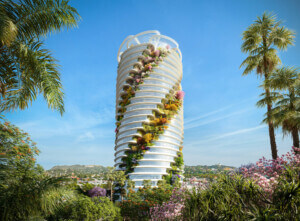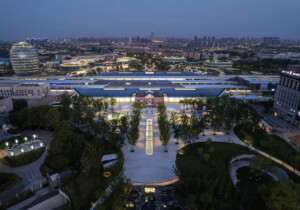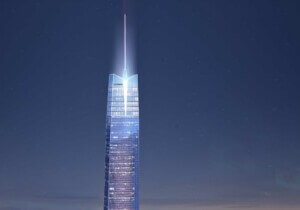On June 13th the Chicago-based Council on Tall Buildings and Urban Habitat (CTBUH) announced their choices for this years best tall buildings in the world. The CTBUH, an international not-for-profit association, picked four regional winners, including the Absolute Towers in Mississuaga, Canada for the Americas; 1 Blight Street, Sydney for Asia and Australia; Palzzo Lombardia, Milan, representing Europe; and Doha Tower, Doha, Qatar for the Middle East and Africa. These four buildings were recognized for making “an extraordinary contribution to the advancement of tall buildings and the urban environment, and for achieving sustainably at the broadest level,” according to a statement from the CTBUH. Additionally, the Al Bahar tower in Abu Dhabi won the first ever Innovation Award for its high-tech computerized sunshade.
Together, these projects represent a global renaissance in the development of tall buildings, highlighting innovations in high design, big engineering, and groundbreaking green technologies. According to CTBUH, a record number of buildings over 200 meters were completed last year, with 88 in 2011 compared to 32 in 2005. 2012 will prove to be the biggest year yet for tall buildings, with 96 set to be completed.
CTBUH will name the “Best Tall Building Worldwide” at their Annual Awards Ceremony at the Illinois Institute of Technology’s Crown Hall on October 18th.
Absolute Towers – Missisuaga, Ontario, Canada
Tower 1: 589 feet. Tower 2: 529 feet.
MAD Architects of Beijing brought a new sensuality to this fast growing Toronto suburb with a pair of curving condominium towers. While contributing to a growing trend of high-profile sinuous skyscrapers, including New York by Gehry, Chicago’s Aqua Tower, and the Capital Gate by RMJM Dubai in Abu Dhabi, the two Absolute Towers go above and beyond their contemporaries as the entire buildings twist and turn to achieve their naturalistic forms.
Dubbed the “Marilyn Monroe towers” by locals for their voluptuous designs, the two structures are wrapped in balconies around the entire facade. “The building is sculpture-like in its overall effect,” said lead architect Ma Yansong, “and its design expresses the universal language of audacity, sensuality, and romance.”
1 Bligh Street – Sydney, Australia
507 feet
Designed by Ingenhoven Architects of Germany and Australian firm Architectus, One Bligh Street is the most sustainable office tower in Australia and the first Australian tower honored by the CTBUH. Located in Sydney’s central business district, the elliptical building contains Australia’s tallest naturally ventilated skylight atrium, which extends the entire height of the structure allowing sunlight to pour into the interior and adding a sense of openness throughout.
Cementing its place as a sustainability leader, One Bligh features a basement sewage plant which recycles 90% of the building’s waste water, a double skin façade with automated external louvers that adjust according to the sun’s location, and uses hybrid gas and solar energy for temperature control.
Palazzo Lombardia – Milan, Italy
529 feet
In the first Italian tower honored by CTBUH, Pei Cobb Freed and Partners have combined sleek design, sustainable technology, and a variety of public spaces in this fashionable mixed-use government center fit for the style capital of Europe. Built as the seat for the regional government offices of the Lombardy region, the complex integrates a thin office tower flanked by smaller 7- to 9-story curvilinear buildings that snake around its base. The shorter office “strands” house cultural, entertainment, and retail facilities and surround a series of interconnected public plazas and parks, the largest of which recalls Milan’s famous Galleria with its curved glass roof.
The project makes use of its proximity to an underground river with geothermal heat pumps that cool and heat the buildings. Other ecological efforts include 7,000 square feet of green roofs, photovoltaic panels on the southern facade, and double-layer active climate walls containing rotating aluminum shading fins.
Doha Tower – Doha, Qatar
780 feet
Recalling his Torre Agbar in Barcelona, Jean Nouvel has constructed another interestingly-shaped tower, this time as an innovative and contextual landmark for the capital of Qatar. The Doha Tower is the first tall building to use reinforced concrete dia-grid columns in a cross shape, maximizing interior space by eliminating a central core. While its cylindrical, dome-topped shape is eye-catching enough, the tower really stands out for its complex, layered facade. Composed of a series of aluminum bris-soleils based on traditional Islamic geometric screens, or mashrabiyas, the building’s skin connects local vernacular designs to the extremely modern tower while providing shade for tenants and creating a rich exterior texture.
Al Bahar Towers – Abu Dhabi, United Arab Emirates
475 feet
This pair of towers by Aedas Architects has been honored with the first-ever Innovation Award for their modern and technologically advanced take on the mashrabiya. While traditionally made of wood latticework, the sunscreen of the Al Bahar is made up of over 1,000 computerized umbrellas composed of Teflon-coated fiberglass mesh panes on triangular steel and aluminum frames. Powered by photovoltaic cells on the buildings’ roofs, these shades open and close as they respond to the sun, providing 80% shading and reducing solar gain by over 50% without resorting to visually impeding tinting. The scale of this highly dynamic skin has never been achieved before, demonstrating new levels of innovation within a contextual aesthetic framework.










